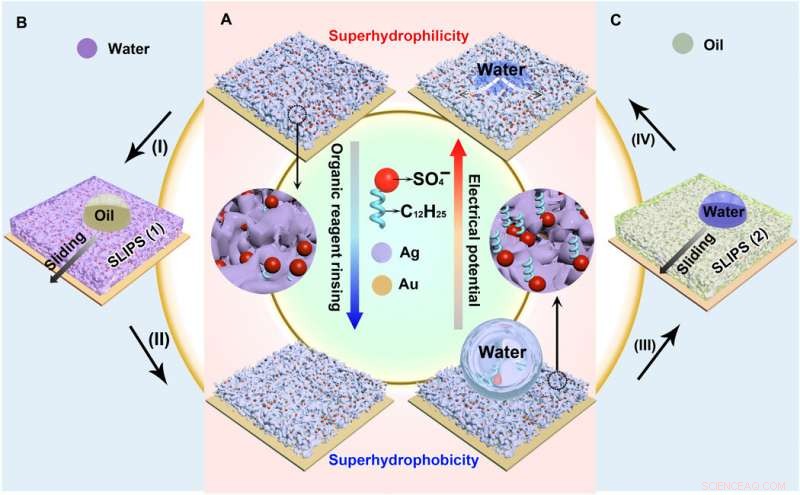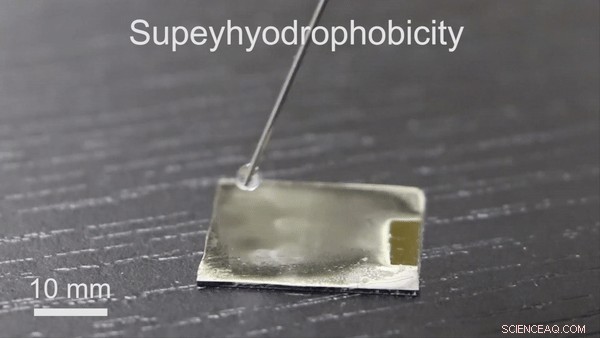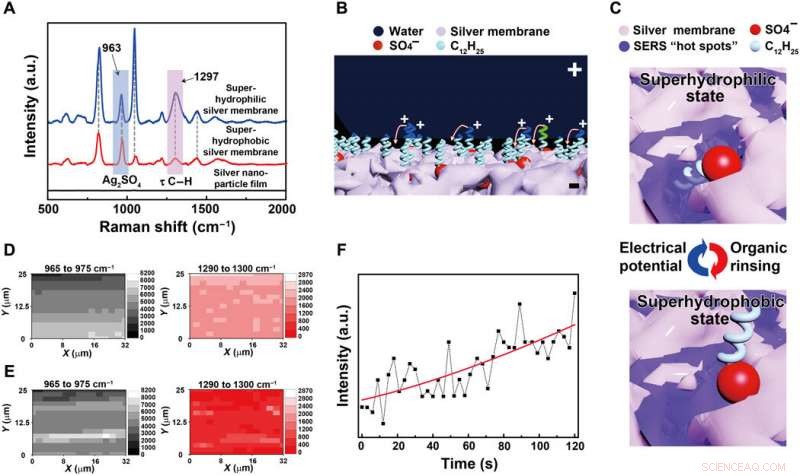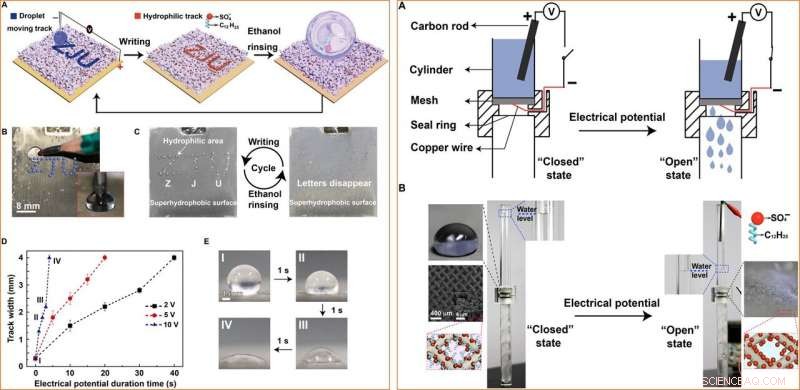
Reversibelt växlande vätbarhet och vätskeavstötning av de elektroavsatta silverporösa membranen. (A) Reversibel vätbarhetsövergång från superhydrofil till superhydrofob, möjliggörs av orienteringsändringen av dodecylsulfatjonerna. (B) SLIPS 1 bildas genom att infundera vatten i det superhydrofila porösa membranet (process I), som kan stöta bort olja. Efter sköljning med etanol (process II), SLIPS 1 blir superhydrofob. (C) Olja infunderas i det superhydrofoba porösa membranet (process III), bildar SLIPS 2. Vatten kommer att stötas bort av SLIPS 2. Smörjoljan kommer att frigöras från SLIPS 2 under en elektrisk potential (process IV), ger upphov till ett superhydrofilt poröst membran. Kredit:Science Advances, doi:10.1126/sciadv.aax0380
Materialtekniken syftar till att kontrollera vätbarhet och vätskeavstötning av materialytor för olika tillämpningar inom och utanför materialvetenskapens område. I en färsk rapport om Vetenskapens framsteg , Yue Liu och ett team av forskare vid avdelningarna för materialvetenskap och teknik, och kemi och molekylär teknik i Kina utvecklade ett allmänt koncept för att utveckla metalliska porösa ytor med exceptionellt kraftfulla, vätbarhetsomkopplarförmåga. För att konstruera de nya ytorna, de använde en extremt enkel, elektrokemisk avsättningsprocess i ett steg. Teamet aktiverade vätbarhetsomkopplaren och manipulerade vätskeavvisande egenskaper genom att ändra orienteringen av dodecylsulfatjoner som var joniskt bundna till porösa metallmembran under elektroavsättning. De resulterande ytorna med justerbar vätbarhet kan vid behov fånga olika smörjmedel i porerna för att skapa vätskeinfunderade porösa ytor anpassade för en mängd olika vätskeavstötande egenskaper. Forskargruppen demonstrerade tillämpningarna av vätskeinfunderade porösa membran för kryptering, för att kontrollera droppöverföring och för vattenskörd. Dessutom, materialforskarna belade det porösa silvermembranet på ett kopparnät för att konstruera en smart, antifouling vätskeport för att tillåta olja eller vatten att passera igenom på begäran.
Inom materialteknik, forskare strävar efter att utveckla reversibelt omkopplingsbara gränssnittsegenskaper för olika tillämpningar från mikrofluidiksystem, till vattenskörd och transport, samt separatorer, sensorer och läkemedelstillförselsystem. Materialforskare har utförligt studerat sådana omkopplingsbara vätbarhetsytor kontrollerade via externa stimuli inklusive ljus, PH värde, termisk och elektrokemisk behandling, motjoner och elektriska potentialer. I detta arbete, Liu et al. rapporterade en extremt enkel, en-stegs elektrodeponeringsmetod för att konstruera porösa metallytor med robust vätbarhetsomkopplingskapacitet kopplad till enastående vätskeavstötande egenskaper som skilde sig från tidigare rapporterade mekanismer för att konstruera en ny vätbarhetsomkopplare.
Teknisk reversibel vätbarhet på elektroavsatta porösa ytor
Liu et al. modulerade orienteringen av dodecylsulfatjoner som joniskt binds till det porösa membranet under elektroavsättning för att etablera reversibelt avstämbar ytvätbarhet. Till exempel, när dodecylkedjorna pekade utåt, membranet bibehöll superhydrofobicitet (vattenhatande natur). Sedan använde forskarna elektriska potentialer för att övergå vätbarheten från superhydrofobt (vattenhatande) till det superhydrofila (vattenälskande) tillståndet. De bekräftade förändringar av jonisk ytorientering med ytförstärkta Raman-spridningsmätningar (SERS). Baserat på den joniska orienteringsinducerade utvecklingen av elektroavsatta porösa ytor, forskargruppen fångade bestämt olika smörjmedel i porerna för att bilda olika "hala vätskeinfunderade porösa ytor (SLIPS)" för flera applikationer.

Tillverkning och karakterisering av de porösa membranen i spån. (A) Svepelektronmikroskopbild av det elektroavsatta silverporösa membranet. Infälld:Förstorad bild. (B) Den aritmetiska genomsnittliga grovhetshöjden för silvermembranen elektroavsatt vid 1,5 V under olika tider. (C) Kurvorna I och II är vattenkontaktvinklarna på de framställda och de etanolbehandlade silverporösa membranen framställda vid 1,5 V för olika tider, respektive. Kurva III är vattenkontaktvinklarna på den etanolbehandlade silvernanopartikelfilmen elektrolytisk utfälld i vattenlösningar av rent silvernitrat. (D) Vätbarhetsövergången från superhydrofil till superhydrofob kan fullbordas genom behandling med 25 vanliga organiska reagenser. (E) Kontaktvinklar och avrullningsvinklar för det superhydrofila silverporösa membranet efter att ha behandlats med en blandning av vatten och etanol vid olika volymförhållanden. (F) Vätbarhetsövergången från superhydrofil till superhydrofob och tillbaka till superhydrofil under 10 cykler. (G) Det porösa membranets morfologi är oförändrad efter 10 cykler av vätbarhetsövergång. Felstaplarna i (C) till (F) erhålls på basis av minst fem oberoende mätningar. Kredit:Science Advances, doi:10.1126/sciadv.aax0380
Den nya tekniken kommer att ha betydande potential i olika termokemiska tillämpningar på grund av dess tekniska enkelhet, mångsidighet och låg kostnad. För att bilda den reversibla vätbarhetsomkopplaren, forskarna deponerade först ett silverporöst membran på en guldtäckt kiselskiva i en elektrolytlösning innehållande silvernitrat och natriumdodecylsulfat (SDS). När tidslinjen för elektroavsättning ökade, membranets grovhet ökade gradvis, efter fyra minuter, det resulterande membranet var superhydrofilt. Med hjälp av organiska vätskor samt med vatten som innehåller en liten mängd etanol (en volymprocent), the scientists could induce the transition of wettability from superhydrophillic (or superoleophillic; water loving) to superhydrophobic (water hating). The instant transition indicated high sensitivity of the membrane toward organic reagents. The water contact angle also increased (hydrophobic character) when they simply exposed the silver porous membrane to an ethanol atmosphere (i.e organic reagent).

The superhydrophobicity of the organic reagent–treated silver porous membrane. Kredit:Science Advances, doi:10.1126/sciadv.aax0380
Understanding the mechanism of wettability transition
The research team conduced systematical studies to reveal the underlying mechanisms of wettability transition, first by using Fourier transform infrared spectroscopy (FTIR) and X-ray photoelectron spectroscopy (XPS) for surface analysis. They proved the existence of SDS ions within the silver porous membrane to form a monolayer structure similar to a previously well-studied surface. Liu et al. hypothesized that hydrophobic dodecyl chain tails hid inside the pores of the freshly prepared silver porous membrane– prompting the silver membrane to initially demonstrate hydrophilicity due to the exposed, hydrophilic sulfate heads.
When the superhydrophillic surface then encountered organic reagents such as ethanol, the hidden dodecyl chain tails changed orientation to face the organic liquids due to their mutually strong affinity. Due to challenges of proving the changing orientation of the dodecyl chains on the rough porous membranes using conventional scanning tunneling microscopy or atomic force microscopy, the team used SERS. The SERS intensity, which mapped the interactions between dodecyl ionic chains and silver sulfate surface, confirmed the transition that facilitated the membrane wettability switch. When they removed the dodecyl ions using oxygen plasma treatment, they eliminated the wettability switch from the silver porous membrane.

Mechanism of the reversibly switching interfacial properties. (A) SERS spectra of the silver porous membrane at superhydrophilic state and superhydrophobic state and the electrodeposited silver nanoparticle film in pure silver nitrate aqueous solutions. The SERS peaks located at 963 and 1297 cm−1 are assigned to silver sulfate and the torsional vibration mode (τ) of C─H in the dodecyl chains, respektive. a.u., godtyckliga enheter. (B) Schematic illustration of the orientation change of the dodecyl chains under an electrical potential. Positive charges will accumulate at the tips of the dodecyl chains contacting water, rotating them toward the negatively charged silver porous membrane. (C) Schematic illustration of the SERS intensity evolution of the dodecyl chains at different wetting states. At hydrophilic state, dodecyl chains are exposed to the SERS “hot spots” existing within the pores of the silver membrane, resulting in strong SERS signals. At hydrophobic state, the dodecyl chains are far away from the SERS hot spots, demonstrating weak SERS signals. (D and E) The SERS mapping results of silver sulfate and the dodecyl chains when the porous membrane is superhydrophilic and superhydrophobic, respektive. (F) The intensity evolution of the 1297-cm−1 SERS peak from dodecyl chains at a specific location as the electrical potential was applied to the superhydrophobic silver porous membrane (photo credit:Yue Liu, Zhejiang University). Kredit:Science Advances, doi:10.1126/sciadv.aax0380
Applications of the technique—encryption and liquid transfer
Having developed a new concept to engineer reversible wettability, the research team developed a variety of applications such as information encryption, droplet transfer, liquid-repellence, fog harvesting, and smart liquid gate as well as oil/water separation. For information encryption, Liu et al. dragged a pencil that behaved as a cathode electrode immersed in a droplet, upon the superhydrophobic surface connected to the positive pole of the power supply to write the letters "ZJU." The surface then transformed to maintain hydrophilicity and when the scientists exposed the surface to water or steam, the encrypted invisible words were revealed due to surface attachment of water droplets. They could change the speed of encryption and remove the hydrophilic track using ethanol to recycle the surface multiple times for reuse. By changing surface properties, they could also induce conditions of hydrophobic encryption. The research team then made use of strong surface adhesion to transfer water droplets across from superhydrophillic surfaces using ethanol-treated silver porous membranes, where droplets adhered on top of the silver membrane for easy transfer.
Harnessing the liquid-repellent properties for additional applications
Därefter, the research team designed silver porous membranes to change from superhydrophillic SLIPS1 (slippery liquid-infused porous surfaces) to superhydrophobic SLIPS2 to form a repeatable cycle between SLIP1 and SLIP2 surfaces for a desired timeframe. The work described here were a first in study to engineer such complex wetting and liquid-repellent properties with potential for dynamic adjustment to match diverse lubricants. Dessutom, bioinspired by the Namib desert beetle that used patterned hydrophilic and hydrophobic elytra (hardened forewing) to retain or remove water droplets, Liu et al. patterned stripes of SLIP2 for excellent water repellence. They engineered surfaces to adhere water molecules for nucleation on hydrophilic surfaces upon exposure to water mist for outstanding fog harvesting efficiency.

LEFT:Application in encryption. (A) Schematic of the information encryption process. A water droplet is dragged by a pencil connected to the negative pole of a power supply to write letters ZJU on the superhydrophobic surface connected to the positive pole of the power supply. The track turns hydrophilic. When the porous membrane is immersed in water or exposed to water steam, the ZJU letters will appear. Ethanol rinsing can turn the hydrophilic track superhydrophobic, allowing for repeatable usage. (B) The setup for the encryption application. Inset:A pencil behaving as a cathode immersed in a droplet sitting on the superhydrophobic surface. (C) Repeatable usage of the silver porous membrane in encryption applications. (D) The track width as a function of the duration time at 2, 5, and 10 V. The error bars are obtained on the basis of five independent measurements. (E) Photographs of the track created at 10 V for different times (photo credit:Yue Liu, Zhejiang University). RIGHT:Application as a smart liquid gate. (A) Schematic of the setup of the smart liquid gate. (B) At the beginning, the mesh is at the “closed” state because the silver-coated copper mesh is superhydrophobic. Once the mesh is triggered by an electrical potential, it turns to the “open” state, and water starts to pass through the mesh. Inset:The image of a water droplet on and the orientation of the dodecyl sulfate ions on the silver-coated copper mesh at the closed and the open state, as well as the microstructure of the silver-coated copper mesh (photo credit:Yue Liu, Zhejiang University). Kredit:Science Advances, doi:10.1126/sciadv.aax0380
Nästa, the scientists electrochemically coated the silver porous membrane onto a copper mesh for applications as a smart liquid gate. While the original superhydrophobicity prohibited the passage of water, when they applied a negative electric potential to the copper mesh, the surfaces became superhydrophilic for the immediate passage of water. The surface property could be interchangeably engineered by exposure to ethanol vapor, for reuse. Liu et al. similarly engineered silver-coated copper meshes for selective water/oil separation, which differed from existing prototypes for efficient oil and water isolation and transfer.
På det här sättet, Yue Liu and colleagues developed a general concept to engineer metallic coatings with switchable wettability liquid repellence using a simple, one-step electrodeposition method. They harnessed the changing orientation of dodecyl sulfate ions ionically bonded to the electrodeposited porous metallic membrane, with organic reagent treatment or an external electric potential to facilitate the wettability switch. They recycled the wettability transition more than 10 times in the study, while forming diverse SLIPS for a variety of applications. The extremely simple and cost-effective materials engineering approach to form switchable wettability and liquid-repellant materials surfaces will have promising applications in liquid/thermal-related fields within and beyond materials science.
© 2019 Science X Network